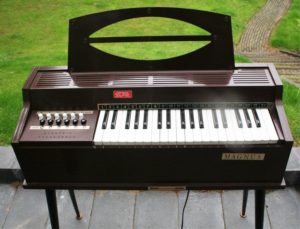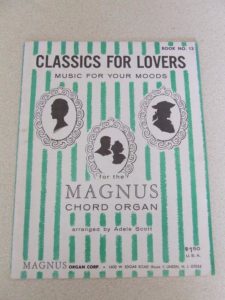
The world was full of budding keyboardists in the 1960’s. However, that didn’t mean homes were full of pianos. Pianos were big, heavy, and expensive. Having one in your home meant that you were committed to playing it, otherwise it just took up space.
The same wasn’t true for a musical instrument that was inexpensive, lightweight, and small enough to tuck away into a closet when not in use.
Chord organs were found in lots of homes during this time. The most common brand was Magnus. Magnus chord organs were made of various shades of plastic. They were made to sit on a tabletop, or there were also models that came on legs. They would necessitate benches with built-in compartments for the sheet music that was also a familiar sight.
We never had a chord organ in our home. I guess that’s a comment on the Enderlands’ musical talent. But lots of my friends had them.
The Magnus chord organ had a fan, which you could hear spin up when you switched it on. When you pressed the keys, you allowed air to blow over certain reeds. The resultant sound was similar to that of a harmonica, which works the same way.

There were also chord buttons on the left side, which could be used to provide nice background sound to your expertly played keys.
Of course, expertly played keys did not necessarily accompany the organs. The sheet music showed you how to play the right notes, but the music actually required talent to be done well, something which I, and many of my friends, sadly lacked.
However, many successful musicians did start out with a humble Magnus chord organ, and used it to propel them on to bigger and better things. A likely upgrade for such a prodigy might be a Hammond organ, capable of all sorts of cool stuff. Its electronically-produced sound made for imitation of different instruments like the trumpet, the clarinet, or the piano.
Most of the time, when I write about old toys and gadgets, I can find a good deal of information on the subjects. That’s not the case with the Magnus organs. Lots of folks remember having them, but nobody seems to know the origin of the toy/musical instrument itself.
I did find one website that stated that Magnus organs originated during the Industrial Revolution. Perhaps they did, but the plastic/electric models we had in our homes more likely arose sometime in the 50’s.
Some households proudly owned nicer wooden Magnuses. They coughed up three-figure prices for the organs, which would then be considered considered real furniture, not to be placed in the closet when not being played..
Nowadays, you can buy nice Casio keyboards capable of some amazing electronic sounds for around a hundred bucks (considerably cheaper than the Hammonds that cost over a hundred 1966 bucks). They will pipe music into your computer, where you can save it as a midi file. While not nearly as commonplace as the Magnuses of the 60’s, many aspiring musicians are discovering their talent by playing with them at a young age, much as we did with our plastic, air-driven chord organs.
I have a very nice magnus 500 wooden chord organ I’ve noticed everybody online selling them say its from the 50’s or 60’s or 70’s nobody knows there exact dates in cant find a date on mine either, any idea of where one would search for this info either one the organ or online? Thanks!